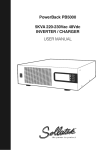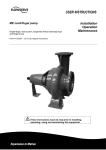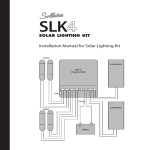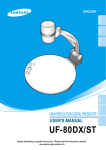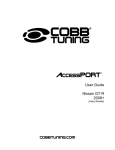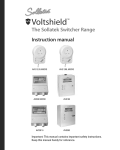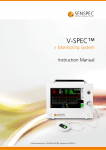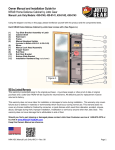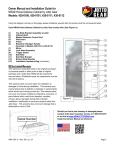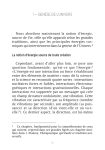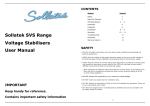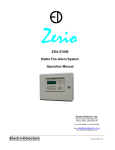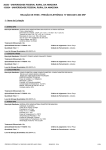Download Glowstar Instruction manual 12p.indd
Transcript
THE SOLLATEK GLOWSTAR Low-cost lighting brilliance – a revolution in solar energy USER'S MANUAL Solar Systems 1. Unpacking and inspection Thank you for purchasing your new Glowstar lantern. On receiving your new Glowstar, make sure the outer packaging is not damaged. Then carefully unpack the unit and inspect the Glowstar casing and lamp. If there is any problem, immediately contact your supplier. Before using Glowstar, leave the light off and fully charge the unit for at least one day (see ‘How to use your Glowstar). 2. Important information To charge your Glowstar you will need at least one of the following items: • AC mains charger, or • Vehicle charge cable, or • Solar panel Glowstar (GS5) and Glowstar (GS7): what’s the difference? Glowstar (GS5) Glowstar (GS7) 5W 7W Lamp Battery 4.4Ahr 7.2Ahr Running time from full charge 5.2 hours 8 hours Auxiliary output* - 12V, 0.5A Auto function** Max charge current Weight - Yes 1.2A (20W) 1.8A (30W) 2.4kg 3.3kg * 12V DC output for running radio, etc – other voltages available. ** Used with mains charger, auto function detects mains power failure and acts as emergency light; used with solar module, detects nightfall and acts as security light. You can use a 5W, 7W or 9W compact fluorescent lamp with both Glowstar models, but running times vary: Lamp & equivalent output Glowstar (GS5) 5W (25W GLS) 5.2 hours* 7W (40W GLS) 3.7 hours 9W (60W GLS) 2.9 hours NB. Times are approximate. * Fitted as standard. Glowstar (GS7) 8.5 hours 6.2 hours* 4.8 hours The following Glowstar accessories are available: Accessory Use with Use with Glowstar (GS5) Glowstar (GS7) Stock No. 5W solar module Yes Not recommended 68005207 10W solar module Yes Yes 68013913 20W solar module Yes Yes contact us AC mains charger Yes Yes 96251000 (UK) 96251050 (euro) 96251100 (us) Vehicle charge cable Yes Yes 64523211 Cigar lighter socket No Yes 64524211 AC mains charger The AC mains charger connects to a normal wall socket (US, UK & European) . It charges a Glowstar (GS5) in about 4 hours and a Glowstar (GS7) in about 6 hours, and can work from 85 to 300V AC (or 120V to 350V DC). The charger can be permanently connected. Vehicle charge cable This connects between the charge input socket on the Glowstar and a 12V vehicle cigar lighter socket. If the engine is off, the lantern will charge slowly and will not reach full charge. If the engine is running, the Glowstar battery will receive more charge. The Glowstar can remain connected to the vehicle socket for long periods. Solar module If your Glowstar package does not include a solar module, you can install your own, provided it meets the following specification: Nominally 12V type Max open-circuit voltage 24V Max short-circuit current: • Glowstar (GS5) 1.3A • Glowstar (GS7) 2.1A • Max peak power: • Glowstar (GS5) 20W • Glowstar (GS7) 30W • Optimum voltage (Vspec.) 14V – 17V • Optimum current (I @ Vspec.): • Glowstar (GS5) 1.2A • Glowstar (GS7) 1.8A • Type: amorphous, poly- or mono-crystalline • Must be robust enough to cope with intended use (eg portable applications) • Must have suitable cable or facility for connection • Module cable will need a standard-type 2.1mm DC plug (available from Sollatek). Polarity: centre contact: positive • Must be of good make and quality, for good service, and reliable operation Charging time when using a solar panel is variable and depends on geographical location, availability of sunlight and cloud cover. DC output adapter The DC output adapter cable plugs into the ‘Aux’ output socket on the Glowstar (GS7) and converts it to a socket like a vehicle cigarette lighter socket. This can then be used to run a mobile phone charger and other small appliances. 3. Safety advice Used with care, Glowstar will give you many years of troublefree service. To make the most of your lantern, please follow these hints: Always: • Keep your Glowstar lantern on charge (when possible). (See section 9: proper care of batteries). This will extend battery life and keep it ready to use. • Keep Glowstar dry; store in moderate to low temperatures. • If charging Glowstar outdoors, keep it in the shade. Remember: • Never immerse Glowstar in water deeper than 160mm. • Never store in extreme conditions or expose to direct sunlight. • Never attempt to open Glowstar yourself (except to change the lamp or battery). • Do not confuse the two DC sockets (on GS7) Charge from solar module 4. How to use your Glowstar Turning the lamp on: Press on/off button (marked ‘I’) once. LEDs will show the battery’s charge status. The left-hand green LED will light when the battery is full. Other LEDs indicate ‘battery good’, ‘battery low’ and ‘lamp off’. To avoid battery damage the lamp automatically turns off when the battery is very low. With about 10 minutes running time left, the lamp will switch off for 1 second and back on as a warning. When the lamp finally turns off, the LEDs will continue to indicate the lamp status for a few minutes. The unit then shuts down to save power. Turning the lamp off: Press the on/off button again. The LEDs will continue to show Glowstar’s status. It will shut down completely after a few minutes. Alternatively, hold the button down again for seven seconds and release; it will then shut down. AUTO* AUX BUTTON & LED OUTPUT* *on Glowstar (GS7) only DC INPUT FROM 12V SOLAR MODULE, MAINS ADAPTER OR VEHICLE CIGARETTE LIGHTER SOCKET Charge from mains • • • BATTERY FULL BATTERY GOOD BATTERY LAMP ON/OFF LOW OFF BUTTON Legends description 5. How to charge your Glowstar’s battery Charge from vehicle 1. Connect your charging source (solar module, mains charger or vehicle lighter socket) to the small side socket marked with a battery symbol. The battery will charge automatically. 2. The yellow charge indicator (above the socket) will light when there is charging power available. 3. You can run the light while you are charging. However, the battery will receive little or no charge. For a correct charge it is best to have the light off (and nothing plugged into the ‘Aux’ socket on Glowstar (GS7)). 4. As the battery charges, indicators will change until the green ‘battery full’ LED lights. To ensure the battery is totally charged, leave power connected for an hour or two longer. 5. It is important to keep the battery fully charged and ready for use. Glowstar should therefore always be connected to the charge source when not in use. If you use the light in the same place as it is charged, there is no need to disconnect the charge cable. 6. Special features of Glowstar (GS7) turn off the light with the on/off button. NB: if Glowstar (GS7) is in auto mode and the solar module faces the lantern, the light may flash on and off. This is because the module detects light from Glowstar at night and ‘thinks’ it is day again. This can be used to attract attention or warn of an emergency. 8. How to change the battery/fuse After a few years of use, the battery may need replacing. This will be evident when the ‘battery low’ LED comes on and then the lamp turns off due to low voltage after only a short time, despite having been fully charged to the green ‘full’ level. It is important to replace the battery with the correct size and type; If unsure contact your Sollatek distributor. 7. How to change the lamp mobile phone charging on Glowstar (GS7) only 1. Unscrew the 2 hex bolts with an M5 hex key, they will not come right out as the are retained. Auxiliary output The side socket (marked with a ‘radio’ symbol) is for running small appliances such as radios, extra lights, mobile phone chargers, and any other appliance or device. It can be used with the lamp on or off. It also can be used during charging (but note that current to the battery will be reduced). Please ensure the battery is replaced with a replacement of the correct type. Contact your Sollatek distributor for details. Simply remove the battery terminal connectors and replace the battery, ensuring the polarity of the battery terminals are reversed on reconnection i.e. make sure the red lead is connected to the red terminal on the battery and that the black lead is connected to the black terminal of the battery. Output current is limited to 0.5Amps @12V. The auxiliary output automatically turns off if the battery gets too low. Pressing the on/off button turns on the lamp and auxiliary output. To use the auxiliary output only, press the button once more. The lamp will turn off whilst the auxiliary output remains on for 1 hour, after which it will automatically turn off. To turn it off earlier, hold down the on/off button for 7 seconds and release. Glowstar will switch off. ‘Auto’ function This allows you to use Glowstar (GS7) as an emergency or security light. If the mains charger is connected and switched on, press the ‘auto’ button. A red LED will light to show automatic mode. If mains power fails, Glowstar (GS7) will automatically turn the lamp on. When mains power returns, the lamp will be automatically turned off and the battery will start to recharge. With a solar module, the auto function turns Glowstar (GS7) into a security light. Place the module outside in sunlight. Run the cable indoors to the Glowstar charging socket. Press the on/off button to turn the light on, then press the auto button. The lamp will turn off in daytime and on after dark. Step 4: To change a battery. After 10,000 hours, you may need to replace your Glowstar lamp. Ensure you use a Philips, Osram or other Sollatek approved lamps. 1. Remove connectors from charge input (and auxiliary output on Glowstar GS7) ensuring lantern is turned off. No LEDs should be lit. 2. Lift off handle/diffuser assembly. 2. Use a Pozi screwdriver to remove the screw at the top of the clear lamp cover. Lift off the two halves of the cover and put them aside. The screw should be held by a fibre washer. It may be necessary to change the fuse in your Glowstar. Please ensure the fuse is replaced with a spare of the correct type and rating. If unsure, contact your Sollatek distributor. 3. Carefully lift lamp from its socket (it is a push fit with a retaining spring-clip; it may be quite firm). Fit the new lamp, ensuring it is pushed fully into the socket and is straight. Step 5: How to change the fuse. 4. Clean lamp covers if necessary with clean water and a little mild soap. Do not use abrasive cleaners. Dry thoroughly. The lamp will light until the battery gets low, automatically turning off at night. At sunrise, the battery will start to recharge ready for automatic operation the following evening. 5. Refit lamp covers by inserting them into the base and closing them at the top. Secure them in place with the screw. Do not overtighten. To cancel auto mode, press the auto button once. If necessary, 6. Press the on/off switch to ensure the new lamp works. Simply remove the fuse from the inline fuse holder and replace with an identically rated spare. See above diagram. 3. Carefully remove the black section and battery from the orange casing and place on a table or workbench. Angle of Glowstar Solar Module from the ground 80º 70º RI S 60º EW Y O PO N E, IC N 50º R R K TL A N D PA If in the southern hemisphere: face your panel directly north. LO ND ON If in the northern hemisphere: face your panel directly south. M A D RI D ST LO U IS KA BU SA N 40º L DI EG CA O IRO MIA 30º MI 20º KHAR O BANGAL TOUM, RE,LAG RA, OS, ACC HARARE M S SALAA I, DAR E NAIROB H O R I Z O N T A L G R O U N D 15º MINIMUM T ILT 0º 9. Proper care of batteries 10. Troubleshooting guide � �������� ������ �������� �� ����������������������������������� ������������������ ��������������������������������������������������� Full capacity will be reached after 2 or 3 full discharge / charge cycles. ��� � �������������������������������� ��������������������������� ���������������������������������������� �������������������������������������������������� • To obtain maximum life, always store batteries in a charged state. � � � � ������������������������ � ����������������������������������������������������������� � ���� • When storing batteries, re-charge every 6 months to prevent damage through self discharge. This should be done more often if storage temperature exceeds 25ºC. � � � � � � ���������������������������������������� ������������������������������������������������������ � ������������������������������������������������������ ����������������������������������������������������� �� � ����������������������������������������������� � ������������������������������� � ������������������������������������������������������������ ������������������������������ • Do not subject the battery to heavy vibration or mechanical shock. • When you receive a new battery, charge fully before use. • • Try to store / use in a cool, dry place. Do not expose to excessive hot or cold (i.e. outside the range 10-35°C ambient temp). � �� ���������������������������������������� ���������������������������� ���������������������������������� �� � ���������������������������������������������� � ����������������������������������������������������� ��������������� ��������������������������������������������������������������� � • Do not attempt to dismantle a battery. They do not require topping up. �� � ���������������������������������������������������������� � ������������������������ ������������������������������� ���������������������������������� ����������������������������������������� • Do not incinerate batteries. Always recycle old batteries. �� � �������������������������������������� � ������������������������������ � ��������������������������������������������������������������� � ������� �� � � � �������������������������������������������� � � � �������������������������� ������������������������ � ����������������������������������������� ������������������������������������������������ ����������������������������������������������������������� � ���������� ������������������������������������������������������������ � � � � ������������������������������������������������� � ������������������������������������������������������������ � ���������� � � ������������������������������������������������������ ���������������������������������������������������� �� � � � � ������������������������������������������������� ������������������������ � � � ��������������������������������������� � � � ���������������������������������������������������������� ��������������������������������������������������������������������� ����������������������������������������������������������������������� ������� ��� � � � � � � � � ��������������������������������������������� ��������������������������������� � � � � � � � ��������������� � � ����������������������������������������� � � ������������������� � ��������������������������������������������������������� � ��������������������������������������������������������������� ���������������������������������� ������������������������������������������������������� � ������������������������������������������������������������������ ���������������������� ������������������������������������������������������������ ������������������������ ��� � � ��� � � � � ������������������������������������������������ � ������������������������������������������������ � ������������������������������������������������������������� � ���������������������������� ������������������������������������������������� ���������������������������������������������� � � � ���������������������������������������������� � � � ������������������������������ �������������������������������������������������������� ������������������������������������������������������������ ��������������� • To prolong battery life, try to avoid the complete discharge of your battery before recovery charge. • Do not discharge a battery deeper than you have to. • To avoid the risk of shock, do not touch the terminals. • Keep terminals free from dirt and corrosion. • Do not short the connections. • Always charge in a ventilated area. • Always use a suitable charging device. If unsure, contact your distributor. • Replace only with Sollatek recommended replacement batteries. If unsure, contact your distributor. 11. Notes on Solar Module Use Note that the black surface of the amorphous solar modules is the active one and should face the sun. The silver surface should face down. Carefully clean the surface of the module once every 6 months or when dust builds up. Use a soft brush. The module can also be wiped with a soft, damp cloth at a cool time of day. Don’t use rough or abrasive cleaners. For portable applications, avoid frequently holding the solar module by one edge and tilting it, as this will in time cause a break along the top of the module. Position the solar module where it gets no shade or shadow over it all day. Make sure vehicles will not run into it or animals knock it over. Charging though window glass will reduce the charging efficiency. Position the solar module to face the sun and adjust the angle so as to make the largest shadow on the ground behind it. For fixed use, the module is best mounted on the roof or some other permanent position where it will not be damaged, moved or stolen. Mount it on a small metal or wooden frame to keep it away from the surface of the roof to allow air to circulate under it. This will improve efficiency by preventing the module from getting too hot. Don't mount it direct on a metal roof or metal surface as this will get too hot. Instead put a wooden board or similar on the metal roof. For fixed use, it should be tilted at an angle from the ground according to the table below and towards the equator. This way it will get the best total sun though out the day and will generally give you the best solar charge throughout the year, taking into account the worst month. Don’t mount it at less than 15º from flat, otherwise it won’t benefit from the natural washing effect of rain. Get into the habit of leaving the Glowstar plugged in to the charge all the time and only remove it when you need to use the lantern in an other room or location. Plug it back in as soon as you have finished. This way it will stay topped up and ready for use all the time. It will also help to give longer battery life. There is no problem leaving the solar module or charger plugged into the Glowstar over night because the Glowstar has reverse discharge protection. Actual solar module appearance may differ Tilt Angle of Solar Module. It is best to face it to the equator, i.e. directly north (if you are in the southern hemisphere) or directly south if you live in the northern hemisphere). This way it will get the best total sun though out the day. Alternatively you can move the module round as the day goes on – if you remember! As a rough guide, tilt it at an angel from the ground as shown in the table below. This will generally give you the best solar charge through out the year, taking into account the worse month. If it is not going to be cleaned regularly, don’t mount it at less than 15º otherwise it won’t benefit from the natural washing effect of rain. Location latitude 0-15° 15-25° 25-30° 30-35° 35-40° 40° + Suggested Tilt Angle from Horizontal 15º Same as latitude add 5° to local latitude add 10° to local latitude add 15° to local latitude add 20° to local latitude Latitude Tilted Angle London, England 51 Paris, N France 48 Nice, S France 43 Madrid, Spain 40 Kabul, Afghanistan 34 Cairo, Egypt 30 Khartoum, Sudan 15 Bangalore, India 13 Lagos, Nigeria 6 Accra, Ghana 5 Nairobi, Kenya -1 Dar Es Salaam, Tanzania -7 Harare, Zimbabwe -17 Seattle 47 Melbourne -37 Perth -32 Darwin -12 Wellington, NZ -41 Rio de Janerio -23 Buenos Aires -34 Lima -12 Belem, Brazil -1 Guatemala 14 NYC, USA 40 Miami, FL, USA 25 San Diego, CA, USA 32 Portland, Oregon, USA 45 St. Louis, MO, USA 38 71 68 63 57 44 37 15 15 15 15 15 15 17 67 52 42 15 61 23 44 15 15 15 60 25 or 30 42 65 53 You can not have too large a solar panel, as long as you don’t exceed the 20W max limit for the GS5 and 30W max for the GS7. The table below shows the recommended peak power of the module. This takes into account the worst month of the year for solar in that location, working on average solar data over the past 10 years. It also assumes using 4 hours of a 5W lamp with a GS5, or 7 hours of a 7W lamp with the GS7. The figures in brackets are the calculated minimum module size. Some generalisations have been made because of variations across a region and there will also be variations due to localised climate conditions. The table is therefore only an approximate guide. Contact Sollatek for information that’s specific to your location and intended use. Location The table below give some examples. Location Which Size of Solar Module? This depends on the Glowstar model you have and on your location on the globe. The table below gives a guide. If you have a module that is too small, then the battery will not be charged fully each day and so the lamp will turn off sooner each evening. This will also mean the battery is permanently in a low state of charge, which over a long period, will have a detrimental effect on battery life. Direction to face South South South South South South South South South South North or South North North South North North North North North North North North or South South South South South South South Tilted Average Insolation Module Wp (sun hours per day) GS5 GS7 Nairobi, Kenya 4.0 Cairo, Egypt 5.0 5 (4) 10 (9.8) Khartoum, Sudan 6.0 5 (3.3) 10 (8.2) Accra, Ghana 3.5 5 (5.7) 20 (14) Lagos, Nigeria 3.5 5 (5.7) 20 (14) Tripoli, Libya 5.0 5 (4) 10 (9.8) Dar es Salaam, Tanzania 4.0 5 (5) 10 or 15 (12.25) 5 (5) 10 or 15 (12.25) Harare, Zimbabwe 5.5 5 (3.6) 10 (8.9) Most of India 4.5 5 (4.5) 10 (10.8) Kabul, Afghanistan 5.0 5 (4) 10 (9.8) Northern France 1.5 20 (13.4) 30 (32.7) Southern France 2.0 10 (10) 30 (24.5) Spain 3.0 10 (6.7) 20 (16.4) England 1.0 20 (20) 50 (49)* * Using the GS7 with a 7W tube for 7 hours a day in winter will require a solar module which exceeds the input rating of the Glowstar. A 30W module should be used and ether a 5W tube used or less that 7 hours running time per day in winter be expected. Other modules available now feature flexible solar modules for the most unforgiving of environments. Ask your sollatek distributor for further details. Sollatek (UK) Ltd. Unit 10, Poyle 14 Industrial Estate, Newlands Drive, Poyle, Slough, Berkshire SL3 0DX, UK Tel: +44 (0)1753 688300 Fax: +44 (0) 1753 685306 Technical support: [email protected] Sales: [email protected] www.sollatek.com www.glowstar.net © Sollatek (UK) Limited 1996 All Rights Reserved. SOLLATEK and the SOLLATEK device are the trade marks of the Sollatek group of companies. Specifications are subject to change without prior notice. Revision No. 2.0 March 05 Solar Systems








